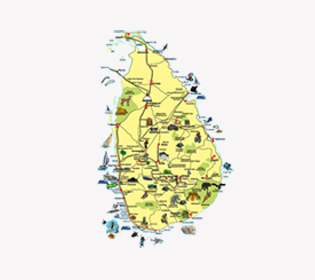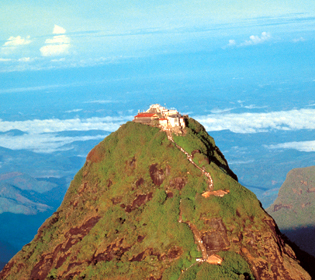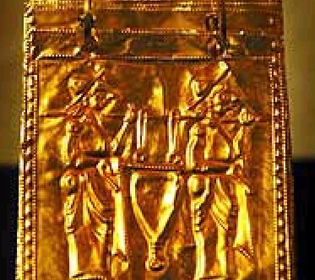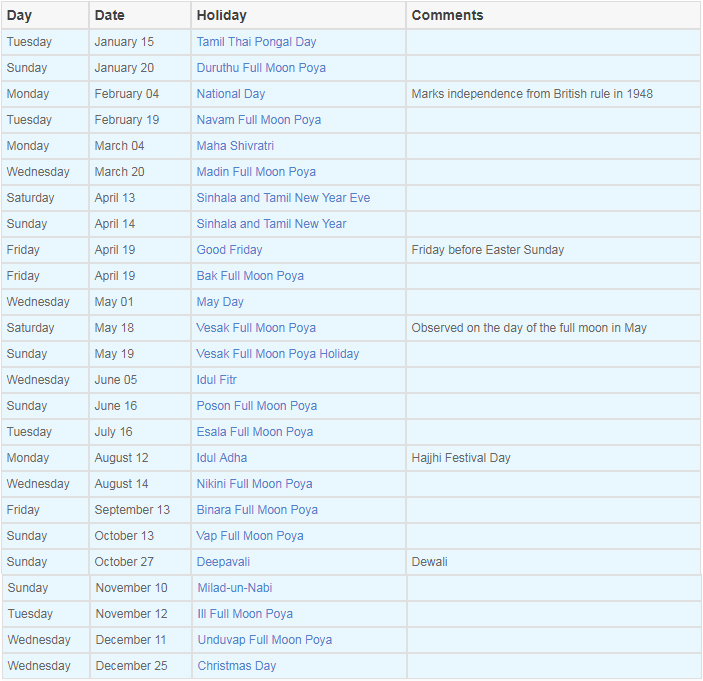
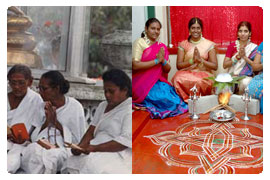
Thai Pongal, the Hindu harvest festival, is celebrated on January 14 in Hindu homes and temples throughout the country. Worship at the kovil (temple) is mandatory for adherents to the faith. Special rituals are held at home too, such as the cooking and ceremonial consumption of traditional sweetened rice called pongal. An observance of a creative nature, kolam, involves making intricate floor motifs with flour. In rural areas, a sequel known as Madu Pongal follows. Domestic animals are washed and fed, auspicious red colour smeared on their foreheads, and finally they are garlanded with marigolds.
Duruthu Poya, the initial full moon day of the Gregorian calendar, commemorates the Buddha's first of three visits to Sri Lanka. The Kelaniya Raja Maha Viharaya or Kelaniya Temple, near Colombo, hosts a perahera, literally procession., to mark this symbolic event. The perahera is a spectacular aspect of Sri Lanka.s festivals in which an array of traditionally-attired dancers, drummers, whip-crackers, acrobats, and enrobed elephants, participate. For visitors it's one of Sri Lanka's most appealing cultural attractions.
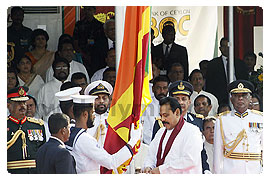
Independence Day, celebrating independence from Great Britain in 1948, falls on February 4. Parades, dances, processions and national games are organized all over the island. But the main event is held in Colombo, attended mostly by politicians.
Commemorates the visit of The Buddha to his home to preach to his father King Suddhodana and other relatives and show them the path to enlightenment and final deliverance
Started in 1979, the Gangaramaya Navam Perahera has since developed into one of Sri Lanka.s finest. Held at night on Navam Poya at the Gangaramaya Vihara in the heart of Colombo, it.s a popular tourist attraction that can be viewed from stands located along the roadside of the procession's route. The fascinating preparations, particularly the arrival of over 100 tame elephants at Viharamahadevi Park during the daytime, can also be observed.
Muslims celebrate the birth of the most important Prophet in Islam by listening to speeches about his life and his teachings
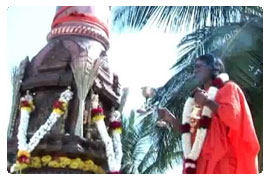
The Hindu festival of Maha Sivarathri, or .The Great Night of Shiva., is celebrated in late February or early March in Hindu homes and temples across the country. This is the most important religious festival of the year for Shaivites, who comprise the majority of Sri Lanka.s Hindus. It is a deeply symbolic occasion: poojas are held at kovils during the day and can be witnessed by visitors, and every Hindu household keeps an all-night vigil.
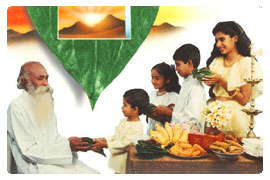
Sri Lankan New Year, which occurs usually on the 13th and 14th of April, is a non-religious festival celebrated by the whole population. Originally a harvest thanksgiving, it does not begin at midnight on the designated day, because, like many events in Sri Lanka, the precise (.auspicious.) timings are decided upon astrologically. It.s believed New Year commences not when the old one ends, but a few hours later. The interval between the old and the new is called nona gathe, or .neutral period., during which all activities cease. When the New Year commences, fresh activities begin: a fire is lit and new clothes are worn. Then comes the gana-denu, or .give and take. in which money is exchanged. The festival culminates when oil is mixed with a herbal paste and a respected elder anoints the head of each family member. Over the festive period traditional games, both indoor and out, such as kotta pora (pillow fighting) and havari hengima (hiding the wig) are played in homes and villages, bringing together families and communities. Many shops are closed for up to a week over New Year as people travel en-masse with gifts and specially prepared festive food to offer to family and friends.
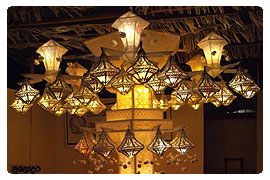
The most important Buddhist full moon day is in May . Vesak Poya - which marks the Buddha.s birth, enlightenment and passing away (Pariniwana). Large pandals (bamboo frameworks) hung with pictures depicting events in the life of the Buddha are erected in the streets, illuminated by flashing coloured light bulbs. Roadside dansalas (stalls) offering free food and soft drinks to passers-by are notable features of the event. Among the many striking Vesak decorations are intricate paper lanterns of different shapes and sizes, and little clay coconut oil lamps (pol-thel pahana) that flicker throughout the island. Visitors to Sri Lanka at this time will not fail to witness and be moved by the beautiful displays of lanterns outside every Buddhist home, business and temple.
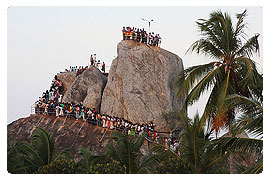
Poson Poya is second in importance to Vesak since it commemorates the introduction of Buddhism to Sri Lanka in 247BC. The focus of this festival is the ancient capital of the country, Anuradhapura, and the mountainous Mihintale Temple, reached by 1,840 steps, where King Devanampiyatissa was converted to Buddhism in the third century BC. During Poson, the mountain is illuminated and devotees climb the steps in their thousands to pay homage to the event
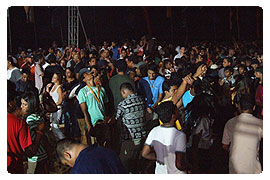
The Hikkaduwa Beach Festival brings this town to life at the end of July for four days of beach-based activities, cultural events and musical shows for the whole family. International DJs, local dancers and musicians headline the event. During the day this famous beach hosts many fun activities - sandcastle building competitions, kite flying, beach rugby, and even movies, to keep everyone entertained.
In the southeast of the island, the sacred site of Kataragama is brought to life with its unique annual Esala festival, which commemorates the victory of the six-faced, 12-armed Hindu war god, Skanda, over an army of demons at Kataragama. Naturally, many Hindu devotees make the pilgrimage to the shrine, but Buddhists, Muslims and some Christians also honour this god. During this 10-day festival pilgrims demonstrate their sincerity by performing astonishing acts of penance and self-mortification. These include walking barefoot atop hot coals and spearing themselves with hooks.
At Dondra, Sri Lanka's southernmost point, just five kilometers from Matara, a notable festival dedicated to Lord Vishnu featuring low-country dances, traditional rituals, a perahera and a handicrafts fair, is held in July. During the same month and commencing on the Esala Poya day is a seven-day festival with a perahera in Unawatuna, near Galle, where thousands of devotees descend on the village and beach.
At Bellanwilla, just south of Colombo, another perahera takes place during the week-long poya festivities held at the historic Rajamaha Vihara.Hindus celebrate a festival known as Vel in July to mark the triumph of Lord Murugan (another aspect of the war god Skanda) over evil powers. A magnificent silver-plated chariot bearing a statue of Lord Murugan leaves a kovil in the Pettah district of Colombo and is pulled to a shrine in another district, Bambalapitiya, followed by musicians and devotees smashing coconuts and singing songs of praise to Lord Shiva. Along the route there are stalls selling sweet delicacies, souvenirs, and handicrafts to passers-by.
The Munneswaram Temple, three kilometres from Chilaw, is another focus of celebration for Hindus in July as they celebrate with fire walking in devotion to Lord Shiva while another small festival is held at the seaside shrine of Udappuwa.
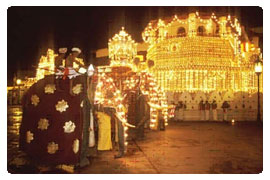
The Nallur Festival in Jaffna in August is the island's longest festival. Spanning 25 days of vibrant chariot processions, drumming, dancing and acts of self-mortification, held in honour of the war god Skanda. Nallur Kandaswamy Kovil or Nallur Murugan Kovil (kovil meaning temple in Tamil) is one of the of the most significant Hindu temples in the Jaffna District of Sri Lanka. It stands in the town of Nallur. The presiding deity is Lord Muruga.The temple hosts the annual Temple car festival. Thaipusam is an annual religious event celebrated by Hindus to commemorate the victory of Lord Murugan over the demon, Tarakasuran. Devotees and penitents can seen bearing kavadis, and piercing their bodies with hooks and spears without seeming to cause any pain or harm as an act of faith and atonement.
Sri Lanka.s most prominent festival is the magnificent Kandy Esala Perahera, held in the hill capital of Kandy over 10 days in August (14th to 25th) and climaxing on Nikini Poya. The perahera.s origins date back to the third century BC, but the modern event originated in the mid-18th century when the Kandyan king decreed that once a year the sacred tooth relic of the Buddha, kept at the Dalada Maligawa, or .Temple of the Tooth., should be displayed in a procession for the people to venerate.
Today, thousands - including many visitors - flock to Kandy during this dazzling ten-day festival, where, under a star-studded moon-filled sky, the streets of the city appear as flowing threads of fire, colour, and stylized motion, mostly created by flaming torches and enrobed and light bulb-encrusted elephants led by the Maligawa Tusker, on whose back is a gold casket containing the relic.
The air is filled with the pulsating throb of a multitude of drums, the ethereal-sounding wail of wind instruments, the wicked crack of whips, even the occasional trumpeting of an elephant. There is quieter participation too, from stilt walkers, acrobats, and the most aesthetically pleasing and traditionally important of all the performers, the dancers.
Almost three hundred of wild elephants gather each evening during this season along the banks of the Minneriya Tank for food, water, shelter -- and match-making.
Asian elephants are renowned as highly social animals and the reservoir or tank meetings demonstrate their complex group dynamics in action.
The atmosphere gives an ideal setting for a world phenomenon, where a high concentration of Asian elephants can be found at a single location during July to October each year.
Hotels in the Minneriya area use the “Gathering” – as it is known- to organize safaris to the Minneriya National Park during the season "The Gathering” giving tourists the chance to observe the elephants feasting and frolicking on the water's edge.
Hotels in Sigiriya, Dumbulla, Habarana and Giritale, in close proximity to the Minneriya Park could be earning a billion rupees collectively in revenue during the Gathering season.
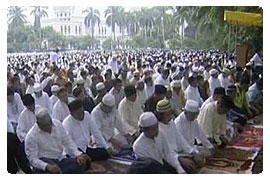
Commemorates The Buddha's visit to heaven to preach to his mother and celestial multitude. Also the commencing of the Bhikkhuni (nun's) Order. Pajapati Gotami approached The Buddha and implored him to establish the Bhikkhuni Order.
Coming with the new moon, the festival marks the end of 'Ramadan a month when Muslims fast throughout the day and eat only at night Prayers, feasts and family get- together are the major highlights of the celebrations. It was during this month that the holy Koran was revealed. Eid means recurring happiness or festivity. Eid is celebrated in India with much enthusiasm and fervor and Muslims from all strata of life can be seen adorned in beautiful new clothes, visiting the mosques to attend Salatul Eid (Eid prayers). Greetings of "Eid-Mubarak" or "a blessed Eid" are exchanged.
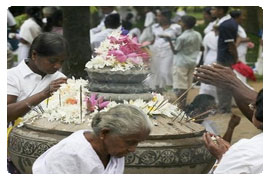
Even before the birth of Buddhism, Asian ascetics in the ancient times when there were no calendars, made it a practice on full moon days to cease worldly pursuits and engage themselves in religious activities. The Buddha adopted this practice and from this developed the preaching of the Buddhist texts and commentaries (bana) in monasteries and temples on full moon Poya days. And when the Venerable Arahat Mahinda Thero introduced Buddhism to this country in 247 BC he also introduced the Poya tradition. Following is a brief description of the 12 Poyas in the Buddhist calendar and their significance. Vap (full moon Poya day in October) The significant events commemorated during this month are: the conclusion of The Buddha preaching of the Abhidhamma for three months to his mother in the Heavenly realm (devaloka), King Devanampiyatissa of Sri Lanka sending envoys to King Asoka requesting him to send his daughter Arahat Sanghamitta Theri to Sri Lanka to establish the Bhikkhuni Sasana (Order of Nuns).
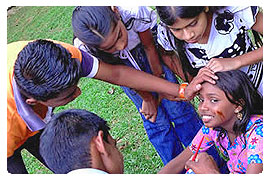
Eid ul-Adha ,or the Festival of Sacrifice is a public and bank holiday in Sri Lanka. Muslims all over the world celebrate this holy day. It falls approximately 70 days after Eid ul-Fitr (end of Ramadan) and is celebrated in honor of the prophet Abraham willingness to sacrifice his son as a proof of his loyalty to God. Celebrations usually include presenting an animal (usually a cow or a sheep) sacrifice, and the meat is shared with family, friends and those in needs. The festival also marks the end of the Pilgrimage or Hajj to Mecca. During the Hajj, male pilgrims are required to dress only in a garment consisting of two sheets of white un hemmed cloth, with the top draped over the torso and the bottom secured by a white sash; plus a pair of sandals.
The Hindu festival Deepavali, or the Festival of Lights (known in India and elsewhere as Diwali) celebrates an aspect of the epic poem, the Ramayana - the homecoming of the hero, the Indian Prince Rama, after a 14-year exile in the forest following his victory over Lanka.s evil King Ravana. In the legend, the people welcomed Rama by lighting rows of lamps, and that.s exactly what happens today. Devotees all over the country wear new clothes and cook sweet dishes to propitiate the goddess of wealth, Lakshmi, who is also associated with the festival.
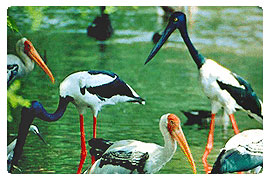
Sri Lanka is home to many colorful birds. Over 400 birds including 33 endemics and 200 migrants have been observed on Sri Lankan soil. The Field Ornithology Group of Sri Lanka (FOGSL) the national affiliate of Bird Life International declared the month of December as the National Bird Month. December is the peak of the Bird Migration season and will record the highest number of birds.
Many activities are being organised to educate the public on the subject of birds. Participants can simply go out bird-watching to as many places as possible.
Unduvap (full moon Poya day in December) Arrival of the Bo-tree sapling. This was brought to Sri Lanka from India by Buddhist Theri Sanghamitta, and it is this very tree that is venerated by Buddhists in Anuradhapura. It is also the oldest documented tree in the world. Sanghamitta Theri established the Bhikkhuni Sasana (the Order of Nuns).
Hatton Adam`s Peak or Sri Pada is an important pilgrim site. The devotees of many religions climb the mountain to invoke blessings. Buddhists believe the impression on the summit is the footprint of the Buddha. Sripada is the 4th highest mountain of Sri Lanka and it takes 4-5 hours to reach the peak by foot. The mountain is also named as Samanola Kanda or Butterfly Mountain. The area is rich in biodiversity and surrounded by the Peak Wilderness Sanctuary. The pilgrimage season starts on Unduvap Poya from December to May.
Sri Lanka is home for many Christians who celebrate Christmas in grand style. The festival season is marked by street decorations in many places of the city. Christmas carols are common and most of the major corporate companies customarily throw Christmas parties, especially on the eve of Christmas. City hotels plan Christmas programmes ahead and hold gala dinner dances on the eve of Christmas. Most of the churches also hold mid-night mass on the eve of Christmas. It is a public and bank holiday.
Traditional activities on New Year Eve include dinner dances, partying till dawn, firecrackers. Most of the hotels in the country will host events to celebrate the New Year. Churches hold mid-night mass on the eve of New Year.
